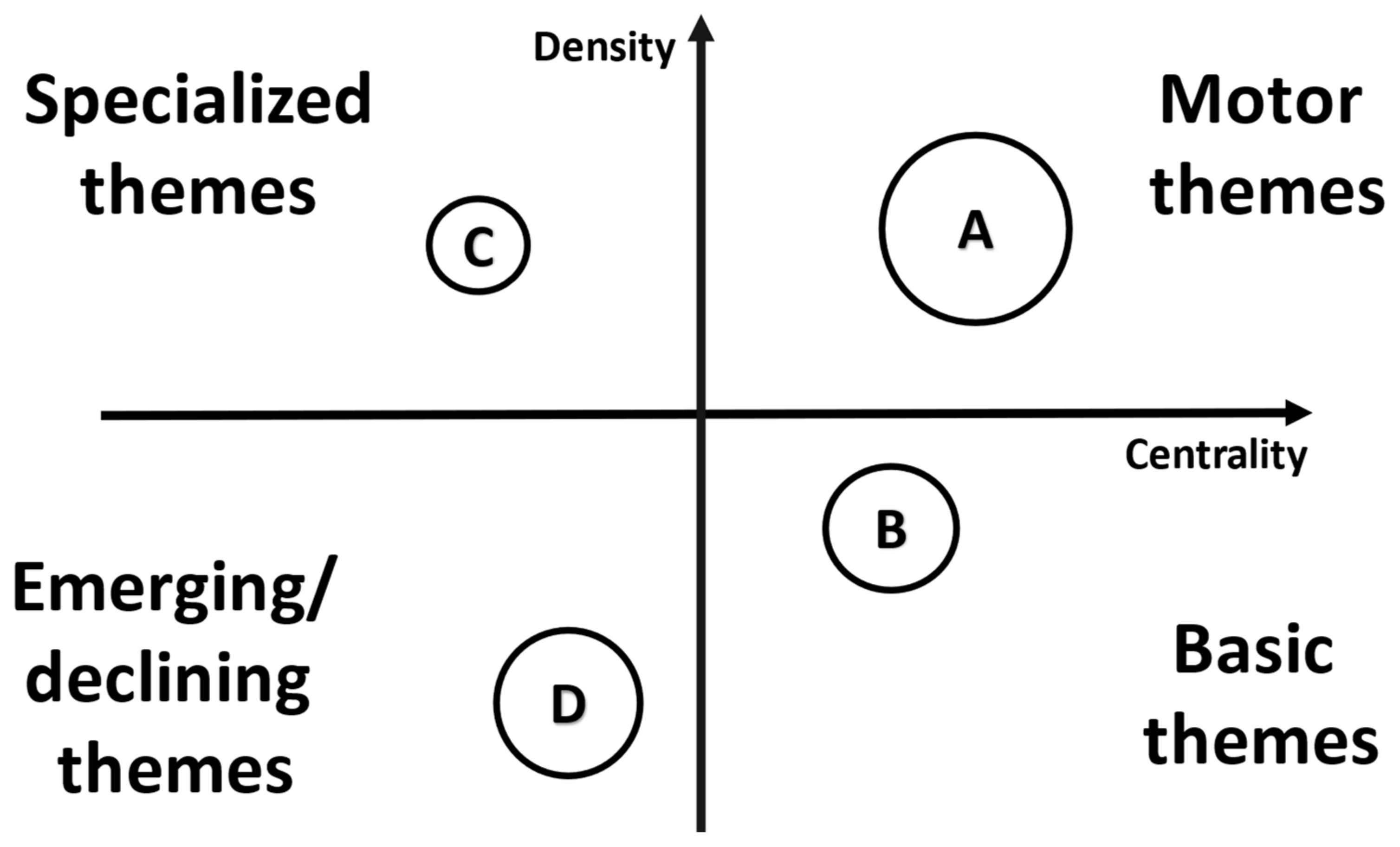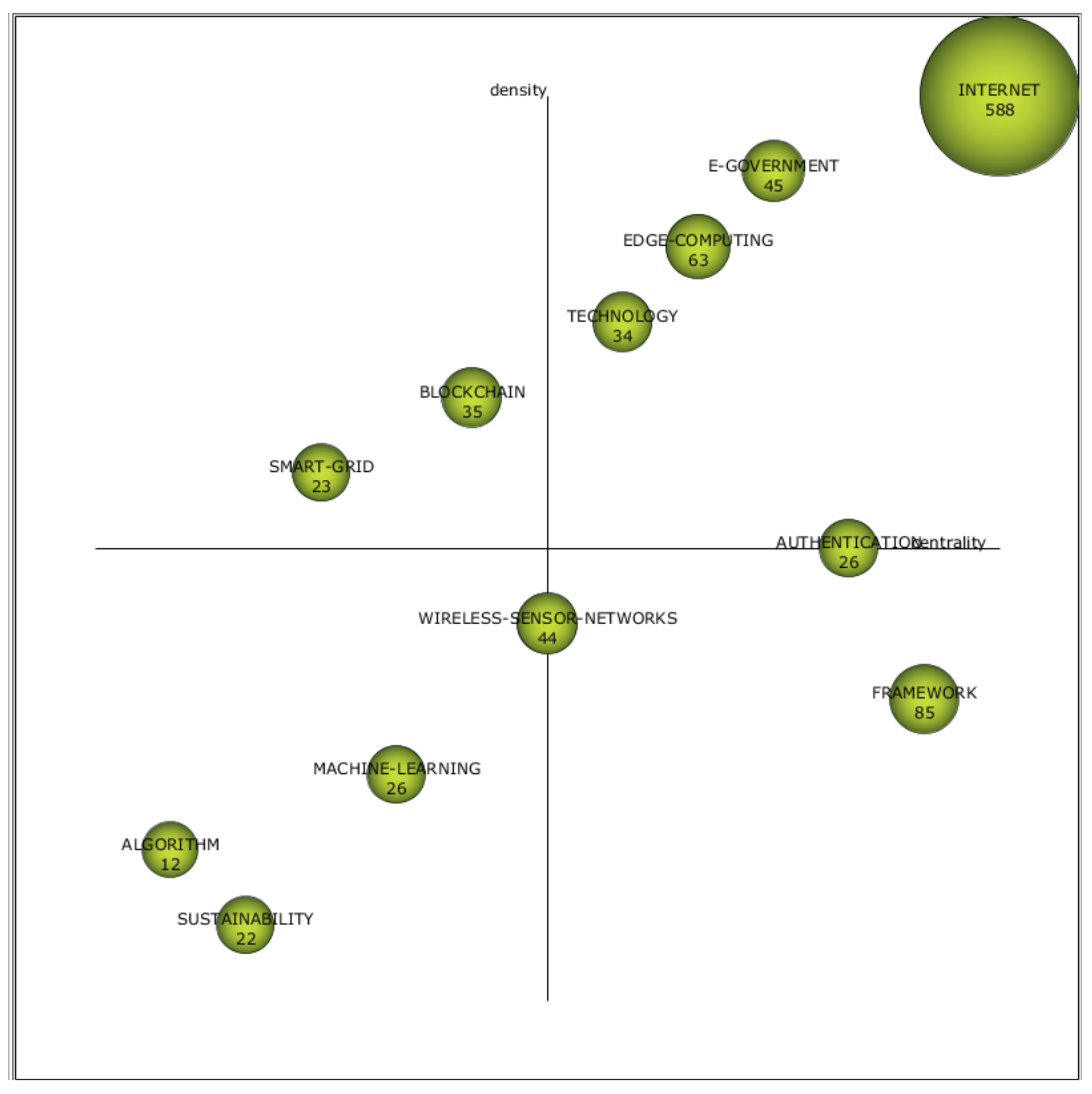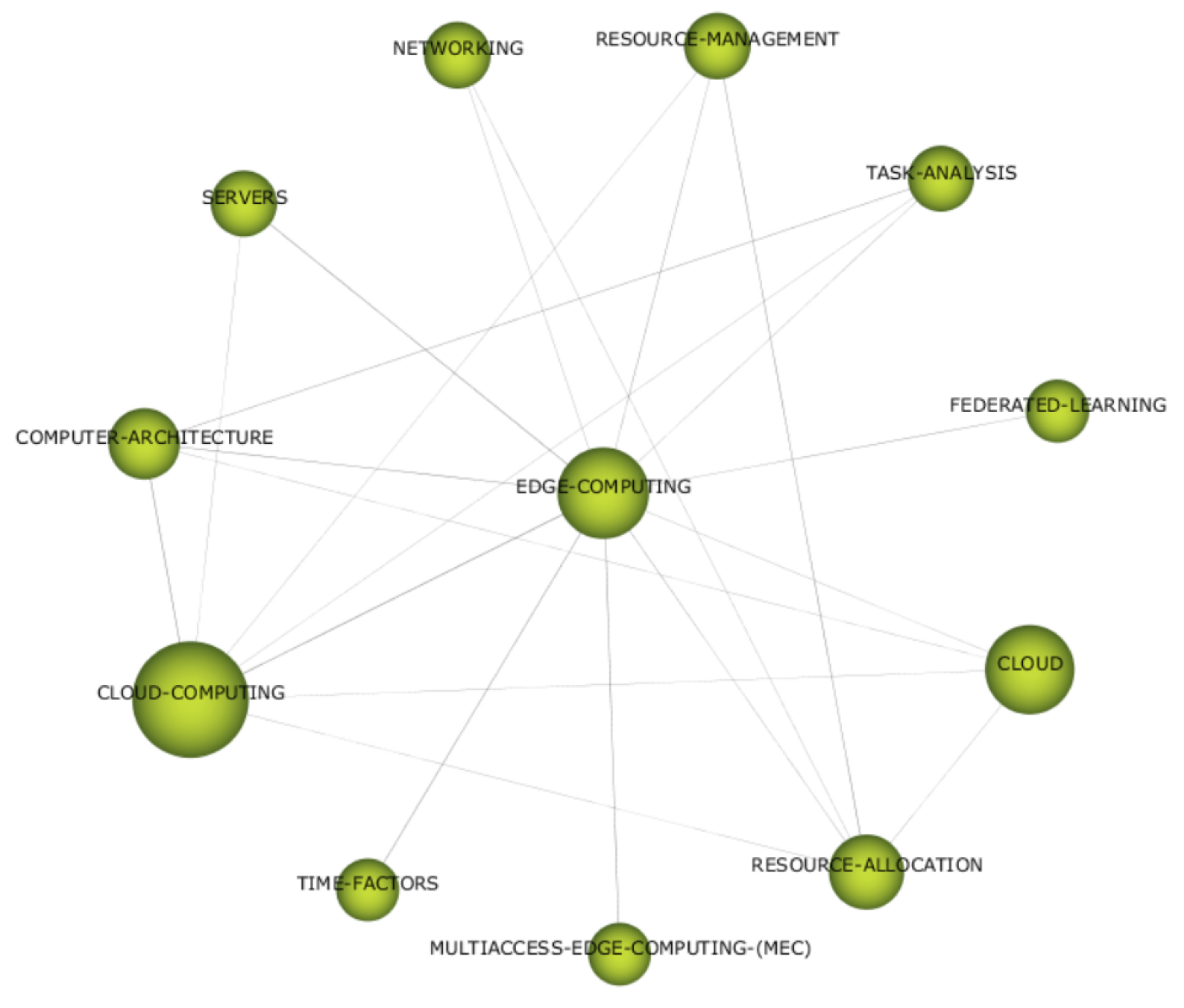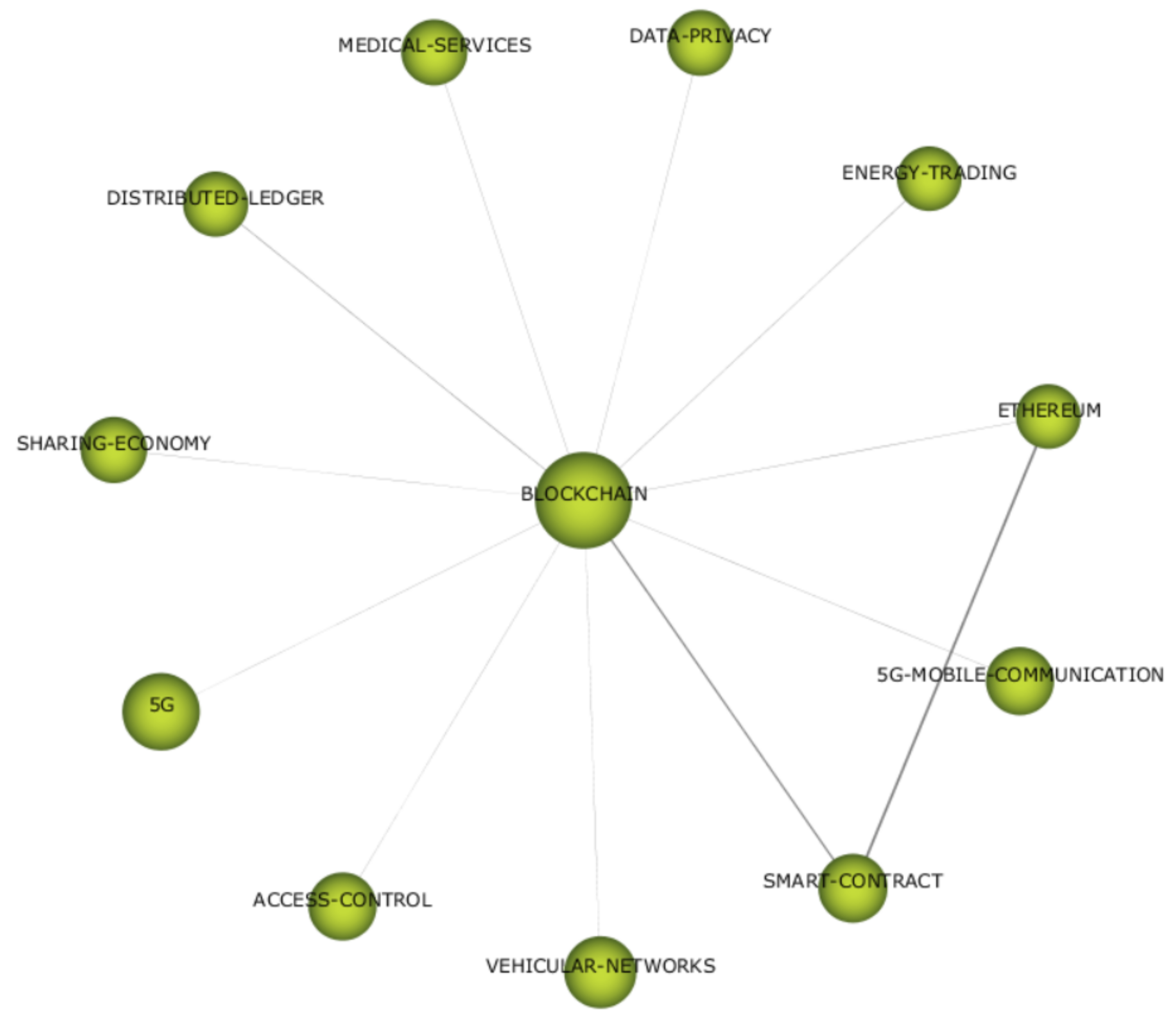Smart Services in Smart Cities: Insights from Science Mapping Analysis
Abstract
:1. Introduction
2. Materials and Methods
2.1. Science Mapping in Bibliometrics
2.2. Science Mapping with the Use of Keywords’ Co-Occurrence
2.3. Strategic Diagram and Thematic Network Analysis in Science Mapping
3. Results
3.1. Strategic Diagram Results
3.2. Services in Thematic Networks
4. Discussion
4.1. Cloud-Computing
4.2. Medical Services
4.3. Smart-City Services
5. Conclusions
Author Contributions
Funding
Institutional Review Board Statement
Informed Consent Statement
Data Availability Statement
Acknowledgments
Conflicts of Interest
References
- Visvizi, A.; Lytras, M. Rescaling and refocusing smart cities research: From mega cities to smart villages. J. Sci. Technol. Policy Manag. 2018, 9, 134–145. [Google Scholar] [CrossRef]
- Visvizi, A.; Perez del Hoyo, R. (Eds.) Smart Cities and the UN SDGs; Elsevier: Amsterdam, The Netherlands, 2021; ISBN 9780323851510. Available online: https://www.elsevier.com/books/smart-cities-and-the-un-sdgs/visvizi/978-0-323-85151-0 (accessed on 13 February 2022).
- European Commission. Digital Agenda for Europe: Rebooting Europe’s Economy; Directorate-General for Communication (European Commission): Brussels, Belgium, 2014. [Google Scholar]
- ISO 37120:2018; Sustainable Cities and Communities—Indicators for City Services and Quality of Life. ISO: Geneva, Switzerland, 2018.
- De Santana ED, S.; de Oliveira Nunes, É.; Santos, L.B. The use of ISO 37122 as standard for assessing the maturity level of a smart city. Int. J. Adv. Eng. Res. Sci. 2018, 5, 309–315. [Google Scholar] [CrossRef]
- Anttiroiko, A.-V.; Valkama, P.; Bailey, S.J. Smart cities in the new service economy: Building platforms for smart services. AI Soc. 2014, 29, 323–334. [Google Scholar] [CrossRef]
- Visvizi, A.; Troisi, O. Effective Management of the Smart City: An Outline of a Conversation. In Managing Smart Cities; Visvizi, A., Troisi, O., Eds.; Springer: Cham, Switzerland, 2022. [Google Scholar] [CrossRef]
- Kashef, M.; Visvizi, A.; Troisi, O. Smart city as a smart service system: Human-computer interaction and smart city surveillance systems. Comput. Hum. Behav. 2021, 124, 106923. [Google Scholar] [CrossRef]
- Allmendinger, G.; Lombreglia, R. Four strategies for the age of smart services. Harv. Bus. Rev. 2005, 83, 131. [Google Scholar]
- Fischer, M.; Heim, D.; Hofmann, A.; Janiesch, C.; Klima, C.; Winkelmann, A. A taxonomy and archetypes of smart services for smart living. Electron. Mark. 2020, 30, 131–149. [Google Scholar] [CrossRef]
- Timeus, K.; Vinaixa, J.; Pardo-Bosch, F. Creating business models for smart cities: A practical framework. Public Manag. Rev. 2020, 22, 726–745. [Google Scholar] [CrossRef] [Green Version]
- Chouk, I.; Mani, Z. Factors for and against resistance to smart services: Role of consumer lifestyle and ecosystem related variables. J. Serv. Mark. 2019, 33, 449–462. [Google Scholar] [CrossRef]
- Mani, Z.; Chouk, I. Impact of privacy concerns on resistance to smart services: Does the ‘Big Brother effect’ matter? J. Mark. Manag. 2019, 35, 1460–1479. [Google Scholar] [CrossRef]
- Lytras, M.D.; Visvizi, A. Information management as a dual-purpose process in the smart city: Collecting, managing and utilizing information. Int. J. Inf. Manag. 2020, 56, 102224. [Google Scholar] [CrossRef]
- Alkhammash, E.H.; Jussila, J.; Lytras, M.D.; Visvizi, A. Annotation of Smart Cities Twitter Micro-Contents for Enhanced Citizen’s Engagement. IEEE Access 2019, 7, 116267–116276. [Google Scholar] [CrossRef]
- Lytras, M.D.; Visvizi, A.; Sarirete, A. Clustering Smart City Services: Perceptions, Expectations, Responses. Sustainability 2019, 11, 1669. [Google Scholar] [CrossRef] [Green Version]
- Malik, R.; Visvizi, A.; Skrzek-Lubasińska, M. The Gig Economy: Current Issues, the Debate, and the New Avenues of Research. Sustainability 2021, 13, 5023. [Google Scholar] [CrossRef]
- Chen, C. Science Mapping: A Systematic Review of the Literature. J. Data Inf. Sci. 2017, 2, 1–40. [Google Scholar] [CrossRef] [Green Version]
- Donthu, N.; Kumar, S.; Mukherjee, D.; Pandey, N.; Lim, W.M. How to conduct a bibliometric analysis: An overview and guidelines. J. Bus. Res. 2021, 133, 285–296. [Google Scholar] [CrossRef]
- Molina-Collado, A.; Salgado-Sequeiros, J.; Gómez-Rico, M.; García, E.A.; De Maeyer, P. Key themes in consumer financial services research from 2000 to 2020: A bibliometric and science mapping analysis. Int. J. Bank Mark. 2021, 39, 1446–1478. [Google Scholar] [CrossRef]
- Garcia-Buendia, N.; Moyano-Fuentes, J.; Maqueira-Marín, J.M.; Cobo, M.J. 22 Years of Lean Supply Chain Management: A science mapping-based bibliometric analysis. Int. J. Prod. Res. 2020, 59, 1901–1921. [Google Scholar] [CrossRef]
- Santana, M.; Cobo, M.J. What is the future of work? A science mapping analysis. Eur. Manag. J. 2020, 38, 846–862. [Google Scholar] [CrossRef]
- López-Robles, J.R.; Rodríguez-Salvador, M.; Gamboa-Rosales, N.K.; Ramirez-Rosales, S.; Cobo, M.J. The last five years of Big Data Research in Economics, Econometrics and Finance: Identification and conceptual analysis. Procedia Comput. Sci. 2019, 162, 729–736. [Google Scholar] [CrossRef]
- Ellegaard, O.; Wallin, J.A. The bibliometric analysis of scholarly production: How great is the impact? Scientometrics 2015, 105, 1809–1831. [Google Scholar] [CrossRef] [Green Version]
- Broadus, R.N. Toward a definition of “bibliometrics”. Scientometrics 1987, 12, 373–379. [Google Scholar] [CrossRef]
- Waheed, H.; Hassan, S.-U.; Aljohani, N.R.; Wasif, M. A bibliometric perspective of learning analytics research landscape. Behav. Inf. Technol. 2018, 37, 941–957. [Google Scholar] [CrossRef]
- Hassan, S.-U.; Haddawy, P.; Zhu, J. A bibliometric study of the world’s research activity in sustainable development and its sub-areas using scientific literature. Scientometrics 2014, 99, 549–579. [Google Scholar] [CrossRef]
- Santa Soriano, A.; Lorenzo Álvarez, C.; Torres Valdes, R.M. Bibliometric analysis to identify an emerging research area: Public Relations Intelligence—A challenge to strengthen technological observatories in the network society. Scientometrics 2018, 115, 1591–1614. [Google Scholar] [CrossRef]
- Hassan, S.-U.; Visvizi, A.; Waheed, H. The ‘who’ and the ‘what’ in international migration research: Data-driven analysis of Scopus-indexed scientific literature. Behav. Inf. Technol. 2019, 38, 924–939. [Google Scholar] [CrossRef]
- Safder, I.; Hassan, S.-U. Bibliometric-enhanced information retrieval: Aa novel deep feature engineering approach for algorithm searching from full-text publications. Scientometrics 2019, 119, 257–277. [Google Scholar] [CrossRef]
- Cobo, M.J.; López-Herrera, A.G.; Herrera-Viedma, E.; Herrera, F. An approach for detecting, quantifying, and visualizing the evolution of a research field: A practical application to the Fuzzy Sets Theory field. J. Informetr. 2011, 5, 146–166. [Google Scholar] [CrossRef]
- Gutiérrez-Salcedo, M.; Martínez, M.A.; Moral-Munoz, J.A.; Herrera-Viedma, E.; Cobo, M.J. Some bibliometric procedures for analyzing and evaluating research fields. Appl. Intell. 2018, 48, 1275–1287. [Google Scholar] [CrossRef]
- Radhakrishnan, S.; Erbis, S.; Isaacs, J.; Kamarthi, S. Novel keyword co-occurrence network-based methods to foster systematic reviews of scientific literature. PLoS ONE 2017, 12, e0172778. [Google Scholar] [CrossRef] [Green Version]
- Su, H.-N.; Lee, P.-C. Mapping knowledge structure by keyword co-occurrence: A first look at journal papers in Technology Foresight. Scientometrics 2010, 85, 65–79. [Google Scholar] [CrossRef]
- Boyack, K.; Klavans, R.; Börner, K. Mapping the backbone of science. Scientometrics 2005, 64, 351–374. [Google Scholar] [CrossRef]
- Aria, M.; Cuccurullo, C. bibliometrix: An R-tool for comprehensive science mapping analysis. J. Informetr. 2017, 11, 959–975. [Google Scholar] [CrossRef]
- Cobo, M.J.; López-Herrera, A.G.; Herrera-Viedma, E.; Herrera, F. SciMAT: A new science mapping analysis software tool. J. Am. Soc. Inf. Sci. Technol. 2012, 63, 1609–1630. [Google Scholar] [CrossRef]
- Cobo, M.J.; López-Herrera, A.G.; Herrera-Viedma, E.; Herrera, F. Science mapping software tools: Review, analysis, and cooperative study among tools. J. Am. Soc. Inf. Sci. Technol. 2011, 62, 1382–1402. [Google Scholar] [CrossRef]
- Callon, M.; Courtial, J.P.; Laville, F. Co-word analysis as a tool for describing the network of interactions between basic and technological research: The case of polymer chemsitry. Scientometrics 2005, 22, 155–205. [Google Scholar] [CrossRef]
- Small, H. Visualizing science by citation mapping. J. Am. Soc. Inf. Sci. 1999, 50, 799–813. [Google Scholar] [CrossRef]
- Gharaibeh, A.; Salahuddin, M.A.; Hussini, S.J.; Khreishah, A.; Khalil, I.; Guizani, M.; Al-Fuqaha, A. Smart Cities: A Survey on Data Management, Security, and Enabling Technologies. IEEE Commun. Surv. Tutorials 2017, 19, 2456–2501. [Google Scholar] [CrossRef]
- Abreu, D.P.; Velasquez, K.; Curado, M.; Monteiro, E. A resilient Internet of Things architecture for smart cities. Ann. Telecommun. 2017, 72, 19–30. [Google Scholar] [CrossRef]
- Ali, Z.H.; Ali, H.A. Towards sustainable smart IoT applications architectural elements and design: Opportunities, challenges, and open directions. J. Supercomput. 2021, 77, 5668–5725. [Google Scholar] [CrossRef]
- Sánchez, M.; Aguilar, J.; Exposito, E. Fog computing for the integration of agents and web services in an autonomic reflexive middleware. Serv. Oriented Comput. Appl. 2018, 12, 333–347. [Google Scholar] [CrossRef] [Green Version]
- Qolomany, B.; Mohammed, I.; Al-Fuqaha, A.; Guizani, M.; Qadir, J. Trust-Based Cloud Machine Learning Model Selection for Industrial IoT and Smart City Services. IEEE Internet Things J. 2021, 8, 2943–2958. [Google Scholar] [CrossRef]
- Bibri, S.E. The IoT for smart sustainable cities of the future: An analytical framework for sensor-based big data applications for environmental sustainability. Sustain. Cities Soc. 2018, 38, 230–253. [Google Scholar] [CrossRef]
- Sohaib Ajmal, M.; Iqbal, Z.; Zeeshan Khan, F.; Bilal, M.; Majid Mehmood, R. Cost-based Energy Efficient Scheduling Technique for Dynamic Voltage and Frequency Scaling System in cloud computing. Sustain. Energy Technol. Assessments 2021, 45, 101210. [Google Scholar] [CrossRef]
- Sirohi, P.; Al-Wesabi, F.N.; Alshahrani, H.M.; Maheshwari, P.; Agarwal, A.; Dewangan, B.K.; Hilal, A.M.; Choudhury, T. Energy-Efficient Cloud Service Selection and Recommendation Based on QoS for Sustainable Smart Cities. Appl. Sci. 2021, 11, 9394. [Google Scholar] [CrossRef]
- Aujla, G.S.; Kumar, N. MEnSuS: An efficient scheme for energy management with sustainability of cloud data centers in edge–cloud environment. Futur. Gener. Comput. Syst. 2018, 86, 1279–1300. [Google Scholar] [CrossRef]
- Abdel-Basset, M.; Moustafa, N.; Mohamed, R.; Elkomy, O.M.; Abouhawwash, M. Multi-Objective Task Scheduling Approach for Fog Computing. IEEE Access 2021, 9, 126988–127009. [Google Scholar] [CrossRef]
- Sookhak, M.; Tang, H.; He, Y.; Yu, F.R. Security and Privacy of Smart Cities: A Survey, Research Issues and Challenges. IEEE Commun. Surv. Tutorials 2019, 21, 1718–1743. [Google Scholar] [CrossRef]
- Tariq, M.U.; Babar, M.; Jan, M.A.; Khattak, A.S.; AlShehri, M.D.; Yahya, A. Security Requirement Management for Cloud-assisted and Internet of Things–enabled Smart City. Comput. Mater. Contin. 2021, 67, 625–639. [Google Scholar] [CrossRef]
- Fang, L.; Zhang, H.; Li, M.; Ge, C.; Liu, L.; Liu, Z. A Secure and Fine-Grained Scheme for Data Security in Industrial IoT Platforms for Smart City. IEEE Internet Things J. 2020, 7, 7982–7990. [Google Scholar] [CrossRef]
- Shen, J.; Liu, D.; Liu, Q.; He, D.; Sun, X. An Enhanced Cloud Data Storage Auditing Protocol Providing Strong Security and Efficiency for Smart City. J. Inf. Sci. Eng. 2017, 33, 923–938. [Google Scholar]
- Gupta, M.; Awaysheh, F.M.; Benson, J.; Al Azab, M.; Patwa, F.; Sandhu, R. An Attribute-Based Access Control for Cloud Enabled Industrial Smart Vehicles. IEEE Trans. Ind. Inform. 2020, 17, 4288–4297. [Google Scholar] [CrossRef]
- Neves, F.; Campos, F.; Stroele, V.; Capretz, M.A.M.; Jennings, M.; Bryant, D.; Dantas, M. Heath-PRIOR: An Intelligent Ensemble Architecture to Identify Risk Cases in Healthcare. IEEE Access 2020, 8, 217150–217168. [Google Scholar] [CrossRef]
- Al Omar, A.; Jamil, A.K.; Khandakar, A.; Uzzal, A.R.; Bosri, R.; Mansoor, N.; Rahman, M.S. A Transparent and Privacy-Preserving Healthcare Platform with Novel Smart Contract for Smart Cities. IEEE Access 2021, 9, 90738–90749. [Google Scholar] [CrossRef]
- Nguyen, D.C.; Ding, M.; Pathirana, P.N.; Seneviratne, A.; Li, J.; Poor, H.V. Federated Learning for Internet of Things: A Comprehensive Survey. IEEE Commun. Surv. Tutorials 2021, 23, 1622–1658. [Google Scholar] [CrossRef]
- Albahri, A.S.; Alwan, J.K.; Taha, Z.K.; Ismail, S.F.; Hamid, R.A.; Zaidan, A.A.; Albahri, O.S.; Zaidan, B.B.; Alamoodi, A.H.; Alsalem, M.A. IoT-based telemedicine for disease prevention and health promotion: State-of-the-Art. J. Netw. Comput. Appl. 2021, 173, 102873. [Google Scholar] [CrossRef]
- Huynh-The, T.; Hua, C.-H.; Tu, N.A.; Kim, D.-S. Physical Activity Recognition with Statistical-Deep Fusion Model Using Multiple Sensory Data for Smart Health. IEEE Internet Things J. 2021, 8, 1533–1543. [Google Scholar] [CrossRef]
- Antunes, R.S.; da Costa, C.A.; Küderle, A.; Yari, I.A.; Eskofier, B. Federated Learning for Healthcare: Systematic Review and Architecture Proposal. ACM Trans. Intell. Syst. Technol. 2022, 13, 54. [Google Scholar] [CrossRef]
- Zhang, Y.; Yutaka, M.; Sasabe, M.; Kasahara, S. Attribute-Based Access Control for Smart Cities: A Smart-Contract-Driven Framework. IEEE Internet Things J. 2020, 8, 6372–6384. [Google Scholar] [CrossRef]
- Islam, J.; Kumar, T.; Kovacevic, I.; Harjula, E. Resource-Aware Dynamic Service Deployment for Local IoT Edge Computing: Healthcare Use Case. IEEE Access 2021, 9, 115868–115884. [Google Scholar] [CrossRef]
- Abu Salim, T.; El Barachi, M.; Onyia, O.P.; Mathew, S.S. Effects of smart city service channel- and user-characteristics on user satisfaction and continuance intention. Inf. Technol. People 2021, 34, 147–177. [Google Scholar] [CrossRef]
- Lytras, M.D.; Visvizi, A. Who Uses Smart City Services and What to Make of It: Toward Interdisciplinary Smart Cities Research. Sustainability 2018, 10, 1998. [Google Scholar] [CrossRef] [Green Version]
- Alam, T.; Porras, J. Architecting and Designing Sustainable Smart City Services in a Living Lab Environment. Technologies 2018, 6, 99. [Google Scholar] [CrossRef] [Green Version]
- Paskaleva, K.; Cooper, I. Open innovation and the evaluation of internet-enabled public services in smart cities. Technovation 2018, 78, 4–14. [Google Scholar] [CrossRef] [Green Version]
- Lee, J.H.; Hancock, M.G.; Hu, M.-C. Towards an effective framework for building smart cities: Lessons from Seoul and San Francisco. Technol. Forecast. Soc. Chang. 2014, 89, 80–99. [Google Scholar] [CrossRef]
- Ji, T.; Chen, J.-H.; Wei, H.-H.; Su, Y.-C. Towards people-centric smart city development: Investigating the citizens’ preferences and perceptions about smart-city services in Taiwan. Sustain. Cities Soc. 2021, 67, 102691. [Google Scholar] [CrossRef]
- Kim, N.; Yang, S. Characteristics of Conceptually Related Smart Cities (CRSCs) Services from the Perspective of Sustainability. Sustainability 2021, 13, 3334. [Google Scholar] [CrossRef]
- Vandercruysse, L.; Buts, C.; Dooms, M. A typology of Smart City services: The case of Data Protection Impact Assessment. Cities 2020, 104, 102731. [Google Scholar] [CrossRef]
- Polese, F.; Troisi, O.; Grimaldi, M.; Loia, F. Reinterpreting governance in smart cities: An ecosystem-based view. In Smart Cities and the UN SDGs; Visvizi, A., Pérez del Hoyo, R., Eds.; Elsevier: Amsterdam, The Netherlands, 2021; pp. 71–89. [Google Scholar]
- Visvizi, A.; Abdel-Razek, S.A.; Wosiek, R.; Malik, R. Conceptualizing Walking and Walkability in the Smart City through a Model Composite w2 Smart City Utility Index. Energies 2021, 14, 8193. [Google Scholar] [CrossRef]






Publisher’s Note: MDPI stays neutral with regard to jurisdictional claims in published maps and institutional affiliations. |
© 2022 by the authors. Licensee MDPI, Basel, Switzerland. This article is an open access article distributed under the terms and conditions of the Creative Commons Attribution (CC BY) license (https://creativecommons.org/licenses/by/4.0/).
Share and Cite
Malik, R.; Visvizi, A.; Troisi, O.; Grimaldi, M. Smart Services in Smart Cities: Insights from Science Mapping Analysis. Sustainability 2022, 14, 6506. https://doi.org/10.3390/su14116506
Malik R, Visvizi A, Troisi O, Grimaldi M. Smart Services in Smart Cities: Insights from Science Mapping Analysis. Sustainability. 2022; 14(11):6506. https://doi.org/10.3390/su14116506
Chicago/Turabian StyleMalik, Radosław, Anna Visvizi, Orlando Troisi, and Mara Grimaldi. 2022. "Smart Services in Smart Cities: Insights from Science Mapping Analysis" Sustainability 14, no. 11: 6506. https://doi.org/10.3390/su14116506
APA StyleMalik, R., Visvizi, A., Troisi, O., & Grimaldi, M. (2022). Smart Services in Smart Cities: Insights from Science Mapping Analysis. Sustainability, 14(11), 6506. https://doi.org/10.3390/su14116506






